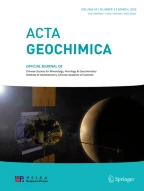1820Accesses
58Citations
29Altmetric
1Mention
Abstract
The use of the term “heavy metal” is regularly questioned by the scientific community. Here, we followed the evolution (1970–2020) in the number of published papers including this term in their title. Thus, we can evidence a continuous, albeit sometimes stabilizing, increase especially in environmental journals. After several other warning opinions, we propose that it should be replaced in the scientific literature by terms like “metal”, “metalloid”, “trace metal elements” or “potentially toxic element”.
This is a preview of subscription content,log in via an institution to check access.
Access this article
Subscribe and save
- Get 10 units per month
- Download Article/Chapter or eBook
- 1 Unit = 1 Article or 1 Chapter
- Cancel anytime
Buy Now
Price includes VAT (Japan)
Instant access to the full article PDF.






References
Ali H, Khan E (2018) What are heavy metals? Long-standing controversy over the scientific use of the term ‘heavy metals’—proposal of a comprehensive definition. Toxicol Environ Chem 100(1):6–19.https://doi.org/10.1080/02772248.2017.1413652
Alloway BJ (2013) Heavy metals in soils—trace metals and metalloids in soils and their bioavailability, 3rd edn. Springer, Heidelberg, p 614.
Antoniadis V, Shaheen SM, Levizou E, Shahid M, Niazi NK, Vithanage M, Ok YS, Bolan N, Rinklebe J (2019) A critical prospective analysis of the potential toxicity of trace element regulation limits in soils worldwide: Are they protective concerning health risk assessment?—A review. Environ Int 127:819–847.https://doi.org/10.1016/j.envint.2019.03.039
Appenroth K-J (2010) What are “heavy metals” in plant sciences? Acta Physiol Plant 32(4):615–619.https://doi.org/10.1007/s11738-009-0455-4
Batley GE (2012) “Heavy metal”—a useful term. Integr Environ Assess Manag 8(2):215–215.https://doi.org/10.1002/ieam.1290
Belkhiri L, Mouni L, Sheikhy Narany T, Tiri A (2017) Evaluation of potential health risk of heavy metals in groundwater using the integration of indicator kriging and multivariate statistical methods. Groundw Sustain Dev 4:12–22.https://doi.org/10.1016/j.gsd.2016.10.003
Bhat UN, Khan AB (2011) Heavy metals: an ambiguous category of inorganic contaminants, nutrients and toxins. Res J Environ Sci 5:682–690.https://doi.org/10.3923/rjes.2011.682.690
Chapman PM (2007) Heavy metal - Music, not science. Environ Sci Technol 41(12):6C
Chapman PM (2012) “Heavy metal”—cacophony, not symphony. Integr Environ Assess Manag 8(2):216.https://doi.org/10.1002/ieam.1289
Chivers PT (2014) Chapter 14 Cobalt and Nickel. In: Binding, Transport and Storage of Metal Ions in Biological Cells, The Royal Society of Chemistry, pp 381–428.
Duffus JH (2002) “Heavy metals” a meaningless term? (IUPAC Technical Report). Pure Appl Chem 74:793–807.https://doi.org/10.1351/pac200274050793
Ghibaudi E (2019) Levi’s Periodic system vs. Mendeleev’s Periodic System: two engaged views of chemistry between science and literature. Pure Appl Chem 91 (12):1941–1947.https://doi.org/10.1515/pac-2019-0604.
Gupta A (2020) Heavy metal and metalloid contamination of surface and underground water. CRC Press, Boca Raton, p 278.
Hodson ME (2004) Heavy metals—geochemical bogey men? Environ Pollut 129(3):341–343.https://doi.org/10.1016/j.envpol.2003.11.003
Hübner R, Astin KB, Herbert RJH (2010) ’Heavy metal’-time to move on from semantics to pragmatics? J Environ Monit 12(8):1511–1514.https://doi.org/10.1039/C0EM00056F
Irawan DE (2020) Keep heavy metal for music not science. Zenodo.https://doi.org/10.5281/zenodo.4134463
Lambers H, Oliveira RS (2019) Plant physiological ecology. Springer, Heidelberg, p 736.
Madrid L (2010) “Heavy metals”: reminding a long-standing and sometimes forgotten controversy. Geoderma 155(1):128–129.https://doi.org/10.1016/j.geoderma.2009.11.031
Nieboer E, Richardson DHS (1980) The replacement of the nondescript term 'heavy metals' by a biologically and chemically significant classification of metal ions. Environ Pollut B Chem Phys 1(1):3–26.https://doi.org/10.1016/0143-148X(80)90017-8.
Nikinmaa M, Schlenk D (2010) Uses of phrases. Aquat Toxicol 97(1):1–2.https://doi.org/10.1016/j.aquatox.2010.02.015
Pourret O (2018) On the necessity of banning the term "heavy metal" from the scientific literature. Sustainability (Switzerland) 10 (8).https://doi.org/10.3390/su10082879.
Pourret O, Bollinger JC (2018) “Heavy metal”—What to do now: To use or not to use? Sci Total Environ 610–611:419–420.https://doi.org/10.1016/j.scitotenv.2017.08.043
Pourret O, Hursthouse A (2019) It's Time to Replace the Term "Heavy Metals" with "Potentially Toxic Elements" When Reporting Environmental Research. Int J Environ Res Public Health 16 (22).https://doi.org/10.3390/ijerph16224446.
Pourret O, Bollinger J-C, van Hullebusch ED (2020) On the difficulties of being rigorous in environmental geochemistry studies: some recommendations for designing an impactful paper. Environ Sci Pollut Res 27(2):1267–1275.https://doi.org/10.1007/s11356-019-06835-y
Wagman JB, Zimmerman C, Sorric C (2007) “Which feels heavier—a pound of lead or a pound of feathers?” A potential perceptual basis of a cognitive riddle. Perception 36(11):1709–1711.https://doi.org/10.1068/p5854
Author information
Authors and Affiliations
UniLaSalle, AGHYLE, 60000, Beauvais, France
Olivier Pourret
Faculté Des Sciences Et Techniques, Université de Limoges, PEREINE, 87060, Limoges, France
Jean-Claude Bollinger
School of Computing, Engineering & Physical Sciences, University of the West of Scotland, Paisley, PA1 2BE, UK
Andrew Hursthouse
- Olivier Pourret
You can also search for this author inPubMed Google Scholar
- Jean-Claude Bollinger
You can also search for this author inPubMed Google Scholar
- Andrew Hursthouse
You can also search for this author inPubMed Google Scholar
Corresponding author
Correspondence toOlivier Pourret.
Ethics declarations
Conflicts of Interest
The author declares no conflict of interest.
Rights and permissions
About this article
Cite this article
Pourret, O., Bollinger, JC. & Hursthouse, A. Heavy metal: a misused term?.Acta Geochim40, 466–471 (2021). https://doi.org/10.1007/s11631-021-00468-0
Received:
Revised:
Accepted:
Published:
Issue Date:
Share this article
Anyone you share the following link with will be able to read this content:
Sorry, a shareable link is not currently available for this article.
Provided by the Springer Nature SharedIt content-sharing initiative
